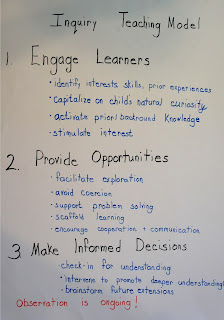For my conceptual interview, I
interviewed three students in my pre-k and kindergarten class at Montessori. I
did a lot of research prior to administering my misconception probes and I
found that children and even adults have many misconceptions when it comes to
rainfall. I thought this topic would be too easy for my students at Montessori
because a lot of them are above average cognitively. However, once I began
administering my probes, I realized that this topic was perfect. My students
all had a private universe in regards to rainfall and I was able to uncover
these misconceptions with them.
My first interview was a
six-year-old girl. When I posed the question “What causes rain to fall from the
clouds,” she responded, “Angels cry and when they get super sad they make the
clouds rain tears and that’s why you can’t drink the rain. I then asked this
student if she knew anything about the water cycle and she did not. I asked her
to tell me why she thought that the angels cried and made it rain and she told me
she remembered reading it in a book when she was four. I showed her two
pictures on my cell phone of the water cycle and a picture of rainfall and I
asked her to look at the pictures and tell me if she still thought that
rainfall happened because of angels and she said “yes.”
My second interview was a
six-year-old boy. After posing the question, he responded, “When warm weather
and cold weather get into a fight in heaven, it rains and one of them wins the
fight. Normally, warm weather wins the fight and that’s why we sometimes have
rainbows after rain storms.” I asked him to tell me about rainfall and tell me
different forms of precipitation that he has seen. He did not know what
precipitation meant so I probed him by giving him the clue that sleet is a form
of precipitation. He gave me the answers snow and hail as two other forms. I
asked him if he knew anything about the water cycle and he said “it starts when
fish spit up water from the ocean and it gets into the air and the wind blows
it up into the clouds and the clouds blow the air back down with the weather
fight.” This was an eye opening experience because it is crazy to see just how
different students responses about the same topic could be.
My last interview was the
closest to being correct about this conception. After posing the question, she
responded, “When clouds get too heavy, they open up and it rains.” She was a
five year old and she is very intelligent for her age and excels in math and
reading. I asked her to tell me what she knew about precipitation and she
responded, “It is a form of rain that comes form the clouds because it came
from water in our atmosphere.” She seemed like she had a very good general
understanding of the concept.
To improve understanding:
1.
I would love to use the ‘Make it
Rain’ lesson that was facilitated to us in class. I think it would be very
beneficial, especially for young students, to develop a concept of rainfall by
seeing it with tangible objects. I would use this to teach students about
rainfall, have them perform an experiment about rainfall and work in a
cooperative learning group.
2.
I would also love to get interactive
science journals for my students and have them observe and describe weather
over time. They could observer rain and record data. We would record what the
clouds look like when it rains, temperature, wind speed and forms of
precipitation. I also think that observing weather would give students an
understanding that certain conditions are necessary for rain to occur. Students
could observe the sky while it is raining and while it is not raining.
3.
I also would teach concepts of
evaporation, condensation and precipitation before giving students the
vocabulary terms and definitions. Students learn best when they learn the
material before the concept.
4.
Another way to teach this, especially
to small children, would be to have them draw a sequence of precipitation and
explain what happens to rain and clouds while it is raining.
5.
To teach a small aspect of this
misconception, my students are creating spring weather pamphlets. They will
draw forms of precipitation in spring and underneath the flap, they will label
the form.






